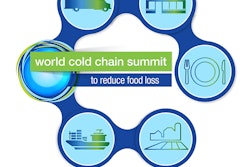
As 2016 comes to a close, we mark another year of exciting developments in our industry. Suffice it to say, there is never a dull moment in the food supply chain industry. The impact of consumers and their demands for a variety of fresh, healthy foods, whether at grocery stores or restaurants, coupled with the interest in online ordering and home delivery, is altering the landscape for food retailers and the logistics providers that support them.
Regulatory compliance remains another top-of-mind issue. The effects of the Food Safety Modernization Act (FSMA) continue to reverberate as food producers, transporters and retailers incorporate new processes and procedures into their operations to ensure a truly safe food supply chain from farm to fork.
Meanwhile, new and emerging technologies are introducing faster, safer and more intelligent ways to design, optimize and manage the food supply chain.
With so much to cover, our editorial team chose to offer a taste of some of these trends in our cover story, from small blurbs to a few longer writeups: We think this captures just how dynamic our industry is and what the future holds for the global food supply chain.
Blockchain for the Food Chain
For the most part, there hasn’t been much news related to blockchain and the food chain, but an announcement by Wal-Mart recently was significant. The retailer is testing how blockchain can be used to identify recalled food items and remove them from store shelves quickly.
“Like most merchants, the world’s largest retailer struggles to identify and remove food that’s been recalled,” according to the Bloomberg article. “When a customer becomes ill, it can take days to identify the produce, shipment and vendor. With the blockchain, Wal-Mart will be able to obtain crucial data from a single receipt, including suppliers, details on how and where food was grown, and who inspected it. The database extends information from the pallet to the individual package.”
Marshal Cohen, chief industry analyst with NPD Group, comments, “It gives [Wal-Mart] an ability to have an accounting from origin to completion. If there’s an issue with an outbreak of E. coli, this gives it an ability to immediately find where it came from. That’s the difference between days and minutes.”
Frank Yiannas, vice president of food safety at Wal-Mart, says blockchain also could help the retailer avoid pulling all potentially affected merchandise and focus on that which is affected.
“With blockchain, you can do strategic removals, and let consumers and companies have confidence,” he says. “We believe that enhanced traceability is good for other aspects of food systems. We hope you could capture other important attributes that would inform decisions around food flows and even get more efficient at it.”
In October, the retailer opened the Wal-Mart Food Safety Collaboration Center in Beijing. It’s also working with IBM and Tsinghua University to use blockchain to improve the way food is tracked, transported and sold to Chinese consumers. If Wal-Mart adopts blockchain to track food globally, it could become one of the largest deployments of the technology to date.
The Customer is King
Although it may not always be apparent, customers still hold considerable power and influence. To appeal to customers’ changing desires of what they want to eat, how, when and where, grocery retailers are rethinking their entire business model. Millennials are helping push these changes. They want more ready-to-eat options at the grocery store; they want home delivery; they want to do everything from their mobile phones.
John Karolefski, who follows these trends on GroceryStories.com, says grocers are getting creative to “enliven what has been a mundane chore.”
The supermarket is becoming digitized, he says. “Retailers will look to connect with smartphone-carrying shoppers, especially millennials who will account for most grocery purchases as they start families. Grocers, such as Marsh Supermarkets and others, are equipping stores with beacons. These Bluetooth-enabled devices connect with nearby smartphones to send ads, coupons or product information to shoppers.”
Electronic shelf labels (ESLs) also are getting more attention from grocers for their ability to display prices, ads and nutritional information, says Karolefski. Several chains are testing them and customers are starting to see them at their local retailer.
Moreover, grocers in urban areas are scaling down the size of their stores to cater to small households, notes Karolefski. “These shoppers will cruise the perimeter for prepared food, dairy, bakery and produce.”
The full-sized stores have their own strategy for attracting customers. “Operators of large supermarkets will take advantage of their space to lure customers with special events,” he says. “More product sampling, nutritional tours and cooking demos will take place.”
Dining at the grocery store is another emerging trend. “Before customers go about their grocery shopping, they can have a bit to eat or something to drink. Operators of many new large supermarkets are including a café with a light menu to nourish customers,” says Karolefski. Some grocers are even adding bars and cafes next to the grocery store, while more continue to add Starbucks to the perimeter of their stores.
In the Driver's Seat
Trucks deliver products quickly and efficiently within the tight timeframes many consumers expect. But as the need for truck fleets rises domestically, bodies to drive them continue to decrease.
The American Trucking Associations (ATA) reports that trucks accounted for 70.1 percent of domestic freight tonnage in 2015, while America’s supply of drivers continued to decrease for the third year in a row. As more drivers are leaving the industry due to retirement, technological demands and stricter standards, the ATA estimates the industry will need more than 96,000 new drivers over the next decade to keep up with growing demand.
Alleviating the shortage is proving challenging, though Tom Scollard, vice president of dedicated contract carriage at Penske Logistics, believes, to attract more drivers, two key factors must be addressed—increased pay and emphasized job desirability for blue-collar employees.
2017: The Year of the ELD
When the American Transportation Research Institute (ATRI) unveiled its list of the top 10 critical issues facing the North American trucking industry, the looming implementation date of the federal mandate on the use of electronic logging devices (ELDs) topped the list.
Starting December 18, 2017, truck drivers will need to scrap their paper logbooks for ELDs. The goal behind this transition is to better track and enforce driver hours-of-service requirements. But getting ELDs into more than 3 million heavy-duty Class 8 trucks nationwide is a major undertaking and one projected to cost trucking operators more than $1 billion.
Experts are urging trucking firms to step up planning to meet the requirements of the mandate. They also are recommending that shippers do their due diligence, and survey core carriers to learn if they are currently using ELDs or have a transition plan in place to implement them. Many experts are expressing concerns that trucking firms are not ready for the mandate.
A Truckstop.com survey in March found 84 percent of trucking companies do not have onboard computers or ELDs, and nearly as many do not plan to add them until shortly before the December deadline. Some respondents even warn they will leave the industry before they will add the recording technology.
Derek Leathers, president and CEO of Werner Enterprises, which gradually added ELDs to its operations, noted at the 2016 NASSTRAC conference that the holdup for many trucking firms is not just the cost of the equipment, but also the ability to deploy the technology within their operations, while “keeping wheels rolling and money flowing.”
But waiting might be folly. Rick Stocking, president and co-CEO of Swift Transportation, predicted in an earnings conference call with Wall Street analysts that shippers will eventually require companies to have ELDs and warns trucking companies will respond in kind by increasing their prices.
There is a light at the end of the ELD tunnel. Though it appears that compliance may prove challenging, the change is also an opportunity to expand in-cab efficiency. ELDs offer routing, navigation and productivity tools that can greatly enhance carrier operations.
We Are What We Eat
Hebert Research Inc. recently found that more than 29 percent of consumers are selecting and consuming organic, fresh and unprocessed foods. This increased demand raises the level of concern food manufacturers have about sustainability, especially in the areas of recycling and waste management.
In an effort to address the growing demand, the Grocery Manufacturers Association partnered with the Food Marketing Institute this year to standardize food waste practices and communicate them to consumers.
In addition to the demand for fresh, unprocessed foods, consumers increasingly are more aware of where their meal is coming from and, more importantly, who is manufacturing it. A recent survey conducted by the The Center for Food Integrity found that consumers actually hold food companies more accountable than farmers, grocery stores and restaurants. What this means for food manufacturers is that transparency is an even more critical area of focus.
The TechSci Research report, “Global Organic Food Market by Product Type, Region, Competition Forecast and Opportunities, 2011–2021,” predicts the global organic food market is projected to grow at a compound annual growth rate (CAGR) of more than 14 percent from 2016 to 2021.
So how can a food manufacturer tackle such a huge issue?Rising Internet penetration, aggressive marketing strategies by major companies and easy availability of these food products on the back of a robust distribution network are projected to boost sales of organic food across the globe. In 2016, about 43.7 million hectares of agricultural land was under organic cultivation and managed by over 2.3 million producers. Leading organic food market players are offering these products in environmentally friendly packaging to lure consumers.
North America and Europe dominated the global organic food market, and accounted for a cumulative revenue share of around 80 percent in 2015. These regions are expected to generate significant demand for organic food products through 2021.
Organic fruit and vegetables dominated the organic food market in 2015. Demand for organic processed food is anticipated to grow at a robust pace during the forecast period, on account of changing lifestyles, the rising working women population base and scarcity of time.
Ocean Carriers and Ports: Late to the Tech Party?
As imports and exports of food products continue to grow, the role that ocean carriers and ports plays also is rising. This year, Food Logistics reported on several developments related to smart reefer boxes, such as those introduced by Maersk Line and CMA CGM. In short, these containers are fitted with hardware and devices that provide improved levels of tracking and tracing, more precise cold chain management, and valuable diagnostic information for the carrier on the status and condition of the reefer boxes in their fleet.
However, two R&D project managers at Valenciaport Foundation, Jonas Mendes Constante and Alexandre Sanchez Perez, contend that ocean carriers and ports are lagging when it comes to adopting and applying technology, and slow in innovating their business models.
“One of the main problems suffered by the port and shipping industry is the lack of innovation,” they wrote on PortStrategy.com. “In fact, in the last 20 years, there has been little activity if we compare with other industries. Whereas the aerospace sector is using data properly, most ships do not even have basic sensors to ensure their hatches are closed before leaving port.”
Indeed, the demise of Hanjin Shipping, overcapacity, historically low rates and dismal growth in world trade don’t make for a rosy outlook for ocean carriers and ports, but this isn’t the time for inaction, warn the executives.
“During turbulent periods, companies are forced to rethink their business models, invest in innovation to open up their possibilities to new markets and identify new systems that offer the chance to reduce business costs.” Furthermore, “There is no magic formula for the process of innovation management,” they suggest. “Executives should invest more resources in external alliances with tech startups, empower and support intra/entrepreneurs, and be involved in innovation projects as partners of research centers and universities.”
The two conclude, “The risk of not taking innovation seriously is as bad as following other ports and shipping companies’ practices, instead of dedicating time to analyze your own needs, challenges and business opportunities.”
Food Industry at the Tip of the IoT Iceberg
The food industry tackles some very complex problems, including food safety and waste management. Foods kept at the wrong temperature, or in unclean or unsafe environments will quickly go bad, adding to food waste or, worse, making people sick.
The Internet of Things (IoT) promises to address these problems through technology. “The use of the IoT will help us understand some very sensitive issues when it comes to food, including temperature and light exposure, to ensure that food is maintained, handled and manufactured in an environment that allows it to have the longest shelf life possible,” says Sean Riley, director of strategic business solutions for Software AG.
The data also will improve product traceability, so companies can efficiently perform product recalls.
To date, Riley states adoption of the IoT is quite low. He explains, “Food manufacturing, transportation and sales are not high-margin businesses, so investments in new technology need an ironclad return on investment (ROI).
“But food manufacturers can expect an ROI in reduced overages, shortages and damages (OS&D),” he says. “Less products will reach their destinations unusable or unpalatable because they were maintained at the incorrect temperature. And retailers will be able to analyze the data pertaining to a shipment and, in some cases, reject or redirect truckloads based on the readings they obtain off the sensors in real time.”
Building greater use of IoT data in the food industry is going to take time, education and technology, adds Joe Scioscia, vice president of sales for VAI. “We are at the tip of the iceberg,” he says. “But I predict we are going to see more and more use of the IoT to improve food safety.”
Greater use will begin with education, especially in the mid-market, according to Scioscia. “They need to learn what we mean by unstructured data and how it can be used for later analysis,” he says.
Riley adds companies also will need to invest in a good application program interface (API) platform to manage the data and a Big Data analytics tool to derive actionable intelligence from the data. Once the tools are in place, Scioscia says, “You’ll see rapid growth of unstructured data and companies really using it as a differentiator.”
Consolidate or Die?
In late August, South Korea’s Hanjin Shipping Co., one of the world’s largest shipping lines, filed for bankruptcy protection, sending shock waves through the global supply chain.The containerized ocean freight industry suffered considerably in 2015 amid financial woes, continuing into 2016 and potentially beyond.
Japan’s three largest shipping companies announced in October they would merge their container shipping operations to create the world’s sixth-largest competitor in an effort to cope with a global decline in the container business.
The downturn led to an increasing number of alliances and moves toward consolidation in the industry, including the world’s 20 biggest container operators, which are all in the midst of a wave of consolidation. Over the past two years, China’s two shipping giants, China Ocean Shipping Company or COSCO, and China Shipping Group, merged their operations; France’s CMA CGM, the world’s third-biggest container operator, bought Singapore’s Neptune Orient Lines Ltd.; and Germany’s Hapag-Lloyd merged with Dubai-based United Arab Shipping Co.
Container ships move 98 percent of the world’s manufactured goods, however, an overabundance of shipping capacity in the water, estimated at 30 percent above demand, is driving most operators deeply into the red, according to an October report by the Wall Street Journal.
Thus, consolidation among the industry’s largest companies is a necessary evil in order to restore balance to the oversaturated market.
Investment firm Jefferies said in an October research report, however, that it retains a negative outlook on the shipping industry, adding that the lengthy timetable for consolidation of the Japanese carriers means the merger “is unlikely to change sector fundamentals” in the near term.Jefferies expects the supply of new ships to continue outpacing demand in 2017, with a net capacity growth of 5.1 percent.
AAPA: Make Ports Part of Infrastructure Improvements
The American Association of Port Authorities (AAPA) recently sent a document to President-elect Donald Trump’s transition team, outlining opportunities to, in the words of the President-elect, “Make America Great Again” through strategic investments in seaports and related freight transportation assets.“
President-elect Trump has put forth an ambitious goal of investing up to $1 trillion to rebuild America’s infrastructure, for which freight transportation and ports are vital components,” said AAPA President and CEO Kurt Nagle. “An enhanced focus on freight transportation and ports would help achieve the new administration’s goal of building a better economic future for America.”
The AAPA document recommends promoting multimodal efforts designed to relieve traffic bottlenecks and expand capacity. These efforts include:
- Providing additional Fixing America’s Surface Transportation (FAST) Act investments and a sustainable freight trust fund to plan and build multimodal projects.
- Establishing a properly funded and staffed Office of Multimodal Freight Transportation within the U.S. Department of Transportation (USDOT).
- Supporting funding for a robust Strong Ports program under the USDOT Maritime Administration to help ports plan for 21st century infrastructure needs.
- Increasing investments for authorized marine highway projects to ensure transportation alternatives alongside congested land transportation corridors and increasing funding for transportation infrastructure grants to $1.25 billion per year.
Irradiation and Food Safety
A Houston-based company has made significant improvements to electronic cold pasteurization (ECP) technology, and has emerged as a leading developer, manufacturer and operator of best-in-class food treatment systems and facilities.
ECP is not new to the food industry, notes ScanTech Sciences. “Other companies that rely on ECP technology use third-party electronic-beam accelerators intended for medical device sterilization, which involves significantly higher dosing and leads to food being degraded in the treatment process.” However, ScanTech has made patented improvements to the established and widely accepted ECP technology.
The company is “the only designer and manufacturer of ECP systems purpose-built exclusively for the treatment of food, enabling precision dosing that eliminates 99.9 percent of foodborne pests and pathogens, while maximizing shelf-life extension,” according to its website.
As for the science behind it, ScanTech explains: “ECP is a non-nuclear isotope method of irradiation that employs highly focused and precise beams of electrons to eliminate 99.9 percent of foodborne pests and pathogens. ECP processing involves moving the food through the ECP electron beams for only milliseconds on a high-speed conveyor. When ECP’s ionizing radiation strikes pests, bacteria and other microbes, its high energy breaks chemical bonds in molecules that are vital for cell growth and integrity. As a result, pests and pathogens either die immediately, or can no longer multiply to cause illness or spoilage.”
ScanTech says the U.S. Food and Drug Administration and numerous organizations around the world have spent more than 30 years studying the safety of irradiated food. “In addition to certifying the process as 100 percent safe for consumers, the agency continues to advocate food irradiation as the new gold standard in food treatment.”
















